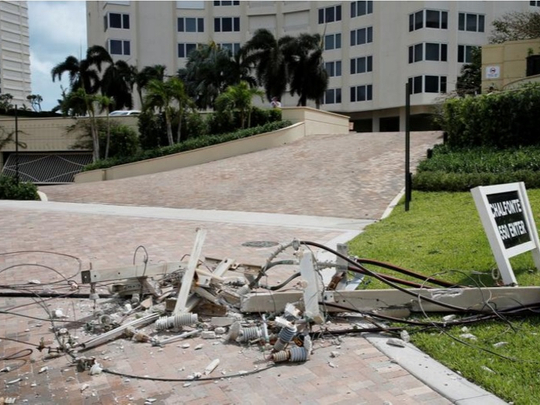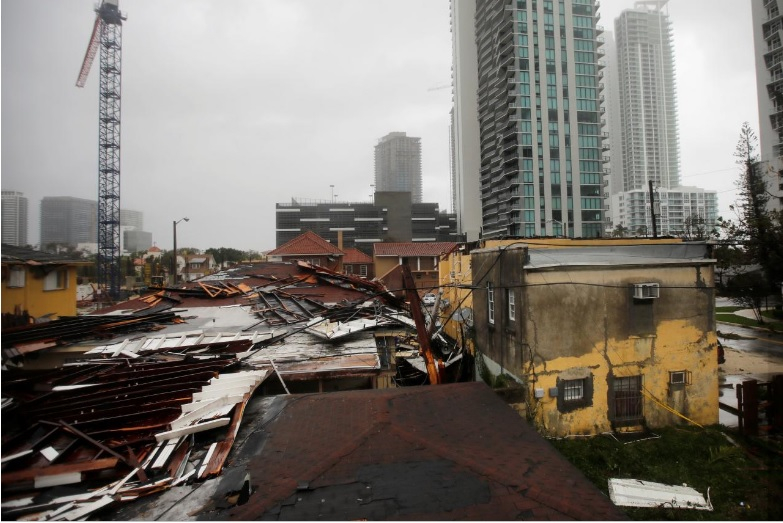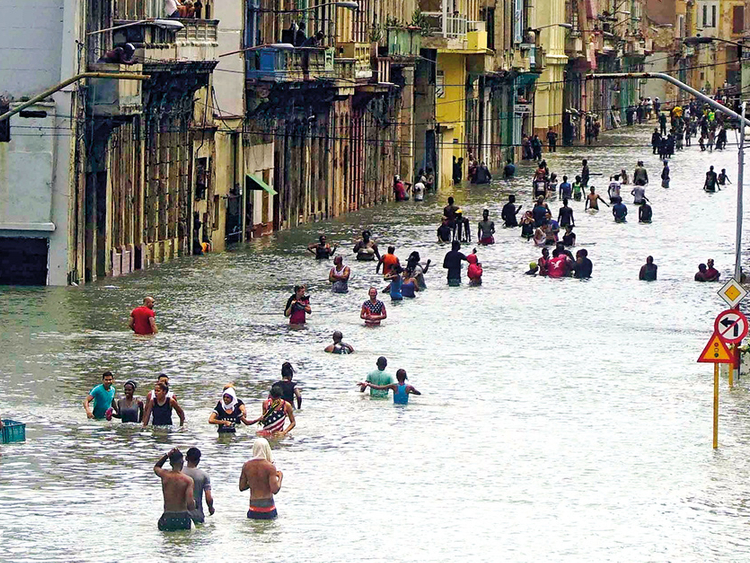
Florida: Over 7.4 million homes and businesses were without power in Florida, Georgia, South Carolina and Alabama because of Hurricane Irma, according to state officials and utilities on Monday.
Most outages were in Florida Power & Light’s service area in the southern and eastern parts of the state.
A unit of NextEra Energy Inc and the state’s biggest power company, FPL said its outages dipped to around 3.4 million by Monday evening from a peak of 3.6 million earlier in the day.
As the storm weakens as it heads toward Georgia, outages have leveled off or even declined at other Florida utilities, while increasing in Georgia, South Carolina and Alabama.
Florida outages for Duke Energy Corp, which serves the northern and central parts of the state, increased to almost 1.2 million, according to the company’s website.
At 5am ET (0900 GMT, 1pm Dubai), Irma was carrying maximum sustained winds of near 120km/h, the National Hurricane Center said.
Hardest hit
Full restoration of power could take weeks in many areas, FPL said, due to expected damage to the company’s system.
Duke’s outages jumped to 860,000 overnight; the company said it expected outages could ultimately exceed 1 million.
Emera’s Tampa Electric utility reported 300,000 homes and businesses lost power by Monday morning.
Nuclear reactor shut down
FPL said its two nuclear plants were safe. It shut only one of the two reactors at its Turkey Point nuclear plant about 48 kilometres south of Miami on Saturday rather than both, because the storm shifted track.
It left reactors in service at the St Lucie plant, about 190 kilometres north of Miami.
There is also spent nuclear fuel at Duke’s Crystal River plant, about 145 kilometres north of Tampa. The plant stopped operating in 2009 and was retired in 2013.
In a worst-case scenario, the spent fuel could release radiation if exposed to the air, but Scott Burnell, of the US Nuclear Regulatory Commission, said that was extremely unlikely.
As the storm loomed and came ashore, gasoline stations struggled to keep up. In the Atlanta metro area, about 496 stations, or 12.2 per cent, were out of gasoline, according to information service Gas Buddy.
Irma, once ranked as one of the most powerful hurricanes recorded in the Atlantic, came ashore in Florida on Sunday and battered towns as it worked its way up the state.
The storm gradually lost strength, weakening to a category one hurricane overnight, the National Hurricane Center said.
By 5am ET (0900 GMT), Irma was churning northwest in the centre of the state and was about 100 kilometres north of Tampa.
Much of the state’s east and west coasts remained vulnerable to storm surges, when hurricanes push ocean water dangerously over normal levels.
That risk extended to the coast of Georgia and parts of South Carolina, the hurricane centre said.
Officials planned to wait until first light on Monday to begin rescue efforts and assess damage, the Miami Herald cited Florida Director of Emergency Management Bryan Koon as saying.
He did not give any numbers on possible fatalities.
Damage appeared to be severe in the Florida Keys, where Irma first came ashore as a category four hurricane with sustained winds of up to 215km/h in the early hours of Sunday, the paper quoted Monroe County Emergency Director Martin Senterfitt as saying.
A large military airborne relief operation was being prepared to take help to the chain of islands, which are linked by a dramatic series of bridges and causeways from Key Largo almost 160 kilometres southwest to the city of Key West, Senterfitt told a teleconference.
Early on Monday, Irma brought gusts of up to 160km/h and torrential rain to areas around Orlando, one of the most popular areas for tourism in Florida because of its cluster of theme parks, the National Weather Service said.
At least 28 killed
In Daytona Beach, a city on the east coast about 90 kilometres northeast of Orlando, city streets were flooded and emergency authorities carried out several water rescues, the Daytona Beach Police Department said on Twitter.
Over the weekend, Irma claimed its first US fatality — a man found dead in a pickup truck that had crashed into a tree in high winds in the town of Marathon, in the Florida Keys, local officials said.
The storm killed at least 28 people as it raged westward through the Caribbean en route to Florida.
Irma was ranked a category five, the rare top end of the scale of hurricane intensity, for days, and carried maximum sustained winds of up to 295km/h when it crashed into the island of Barbuda on Wednesday.
Ahead of Irma’s arrival, some 6.5 million people in southern Florida, about a third of the state’s population, were ordered to evacuate their homes.
Jonathan Brubaker, 51, waited out the storm bunkered in a recently constructed house in Bradenton, on the state’s west coast, with hurricane shutters drawn, flashlights and candles ready.
As a radar app on his phone showed Irma passing by, he had seen little more than gusty winds. He still had power.
“I feel like we kind of dodged bullet on this one,” he said, adding that he would wait until Monday morning before trying to sleep. “And then, I think we’re OK, knock on wood.”
Evacuation
Many of the evacuation orders extended until at least Monday due in part to flooding, massive power outages and downed electric lines, leaving residents unable to return to their homes to survey any damage.
TV news video of damage in Naples, a city on the Gulf coast about 200 kilometres northwest of Miami, showed buildings ripped apart by winds and streets flooded by rain and storm surges.
Miami International Airport, one of the busiest in the country, halted passenger flights through at least Monday.
Irma was forecast to weaken to a tropical storm as it moved near Florida’s northwestern coast on Monday morning, the National Hurricane Centre said. It would cross the eastern Florida Panhandle and move into southern Georgia later in the day, dumping as much as 41 centimetres of rain, it said.
SKYSCRAPERS SWAY IN LASHING WINDS
Five tornadoes were reported in Florida on Sunday, causing damage to several structures but there were no indications of anyone being seriously injured, the National Weather Service said.
Along with hurricane warnings and watches in Florida, the weather service placed tropical storm warnings for large parts of Alabama, Georgia and South Carolina.
The densely populated Miami area was spared the brunt of Irma, although the hurricane’s wide reach meant the state’s biggest city was still battered.
Miami apartment towers swayed in the high winds on Sunday, three construction cranes were toppled, and streets flooded between office towers.
Police in Miami-Dade County said they had made 29 arrests for looting and burglary.
The storm and evacuation orders caused major disruption to transportation in the state, which is a major tourist destination and which accounts for about 5 per cent of US gross domestic product.
Irma, which hit just days after the Houston area was deluged by unprecedented flooding in Texas from Hurricane Harvey, was expected to cause billions of dollars in damage to the third-most-populous US state.
However, European shares rose on Monday in early deals, led higher by insurers as the weakening of Irma raised expectations that costs for the industry might be lower than initially feared.














